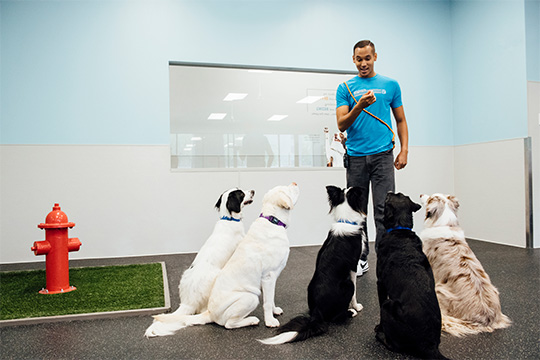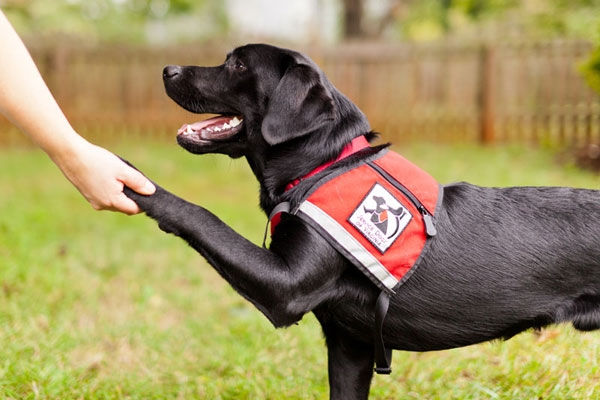Puppy Training That Teaches Key Skills for Lifelong Good Behavior
Newbie's Guide to Successful Pet Dog Training at Home
Effectively educating a canine in your home calls for a nuanced understanding of canine behavior and efficient interaction methods. Establishing clear training objectives, making use of high-grade incentives, and maintaining uniformity across member of the family are important aspects. In addition, integrating training into everyday routines can boost both engagement and retention. Nonetheless, many beginner fitness instructors run into obstacles that may hinder progress. To navigate these intricacies successfully, it's necessary to explore a number of vital facets that can change your technique and lead to an unified partnership with your pet dog. What basic concepts should every novice understanding to guarantee success?
Comprehending Pet Habits
Recognizing dog actions is vital for reliable training and cultivating a harmonious connection between human beings and their canine buddies - Puppy Training. Dogs connect mainly through body movement, vocalizations, and face expressions, making it critical for owners to interpret these signals properly. Identifying habits such as tail wagging, roaring, or trembling can offer insights into a pet's emotion and purposes
In addition, recognizing the all-natural instincts of canines, such as their pack mentality, aids owners develop leadership duties within the household. This is crucial for creating an organized setting where canines really feel protected and are extra receptive to training. Pet dogs are additionally influenced by their socializing experiences; very early exposure to numerous environments, individuals, and other pets can substantially shape their habits later on in life.
Common behavioral concerns, such as hostility, anxiety, or extreme barking, frequently stem from misconceptions or unmet demands. Observing and dealing with these problems without delay can prevent acceleration and make sure a favorable training experience. By cultivating a deep understanding of dog habits, proprietors can tailor their training techniques to match their canine companions, ultimately resulting in a contented and mannerly pet.

Necessary Educating Tools
A well-equipped training room can considerably improve the effectiveness of pet training in the house. Essential training devices make certain that both the canine and the instructor can engage in effective sessions that cultivate discovering and bonding.

Investing in a strong leash and a comfy, well-fitting collar or harness is essential for safety and control. These tools help develop borders and make certain the dog remains secure throughout training. Additionally, a designated training area, devoid of interruptions, aids concentration for both the trainer and the dog.
Educating help such as training pads, cones, or agility equipment can additionally boost the experience by presenting range and difficulties. Finally, having a notebook or electronic application for tracking progression can be important, enabling you to note successes and locations for renovation. Making use of these important tools will produce a positive training setting and lay the structure for efficient understanding.
Creating an Educating Routine
Establishing a consistent training routine is essential for reliable canine training at home. A well-structured routine not just aids in strengthening wanted habits however also offers your dog with a complacency and predictability. To produce an efficient training regular, begin by determining details training objectives, such as standard commands, leash strolling, or house-training.
Select a marked time daily for training sessions, ideally when your pet dog is alert and responsive. Sessions needs to be brief, roughly 5 to 15 minutes, to preserve emphasis and protect against tiredness. Uniformity in timing and setting will certainly enhance your canine's learning experience.
Incorporate training right into day-to-day activities to strengthen skills. Practice commands during walks or mealtime, which integrates finding out right into natural routines. Furthermore, continue to be flexible and adjust the routine as needed, suiting your canine's energy levels and mood.
Positive Support Strategies

When executing favorable support, it is vital to choose incentives that are inspiring for your dog. High-value deals with, such as small items of poultry or cheese, can be particularly reliable throughout training sessions. Additionally, varying the benefits can preserve your pet dog's rate of interest and enthusiasm.
Start with easy commands, like "sit" or "remain," and progressively development to much more complex tasks. Consistency is vital; make sure that all household participants use view publisher site the very same commands and incentive systems to prevent complication.
Additionally, it is vital to continue to be client and prevent aggravation. Pets, like people, discover at their own rate. By promoting an encouraging training environment with favorable support, you can enhance your canine's learning experience while strengthening the bond in between you and your fuzzy buddy, laying the foundation for effective training end results.
Usual Training Challenges
While training a pet dog in your home can be a fulfilling experience, it typically comes with a collection of usual challenges that can evaluate both persistence and consistency. One prevalent problem is disturbance. Dogs may come to be conveniently averted by noises, motions, and even fragrances in their setting, making it difficult to keep their emphasis throughout training sessions.
Another challenge is variance in commands and support. If relative go to website make use of different hints or incentives, it can prevent and puzzle the dog development. Establishing a unified technique is necessary for efficient communication.
Additionally, pets can experience frustration or stress and anxiety, especially if they do not comprehend what is expected of them. This can result in unfavorable habits, such as eating or barking.
Finally, the timing of reinforcement is vital. Delayed rewards can reduce the efficiency of favorable reinforcement, as pets may fall short to attach the actions with the reward.
Conquering these obstacles needs commitment, clear communication, and a structured training strategy - Puppy Training. Acknowledging and dealing with these common obstacles will lead the way for a more effective and enjoyable training experience at home
Conclusion
In final thought, effective pet dog training at home demands a thorough understanding of canine behavior and efficient communication techniques. By developing clear training objectives and making use of premium treats along with favorable reinforcement, the training procedure comes to be a lot more gratifying for both the pet and the trainer.
Developing a constant training regimen is necessary for reliable dog training at home.Positive reinforcement methods are fundamental to reliable pet training, advertising desired habits with rewards instead than punishment. By fostering an encouraging training setting via positive support, you can improve your dog's knowing experience while strengthening the bond between you and your fuzzy buddy, laying the groundwork for effective training outcomes.
In conclusion, successful pet training at home requires a detailed understanding of canine habits and efficient interaction approaches. By developing clear click for more training goals and making use of high-quality treats together with positive support, the training procedure comes to be a lot more gratifying for both the dog and the instructor.